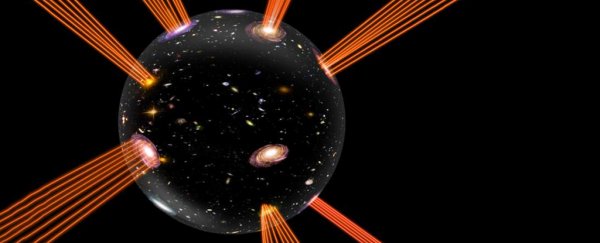Physicists have come up with a bold new idea to explain the enduring mystery of our expanding Universe – we might actually be living in a 'bubble' between other five-dimensional spaces.
If that makes your brain hurt, don't worry, it's supposed to. But we can break this down.
Our Universe as we know it has four dimensions: the three dimensions of space (up and down, left and right, back and forth), and one dimension of time that keeps us all ticking along.
But this new solution from physicists at Uppsala University in Sweden suggests that are other types of space that are five dimensional, and where two of those spaces come together, the junction forms an expanding bubble.
"The whole Universe is accommodated on the edge of this expanding bubble," an Uppsala press release explains.
"It is conceivable that there are more bubbles than ours, corresponding to other universes."
It's pretty crazy stuff, but there's an incredibly important goal here – to try and finally explain what's going on with ' dark energy', the theoretical force responsible for our Universe's constant expansion.
For decades, researchers have tried to solve the dark energy problem using string theory, without a whole lot of luck.
String theory is one of science's "great idea, shame about the facts" concepts. It's elegant, and carries the hope of reconciling incompatible ideas of physics.
It emerged from early efforts to add dimensions to general relativity, suggesting that properties of matter like charge and spin are a consequence of single-dimensional 'strings' wiggling multiple dimensions.
Those strings can behave in a huge variety of ways, depending on how many dimensions you add or other constraining properties, resulting in some 10^500 solutions, of which our Universe's mix of features is just one.
The problem is it's becoming increasingly clear that string theory is also wrong, and incompatible with what we observe in the Universe.
And where it's not even wrong, it's impractical, if not impossible to test. So why bother?
Well, there is more than one way to be wrong in science. Some wrongs are worse than others, and while it has major problems, string theory is like an old car that no longer runs but has plenty of scrap left in it.
Take this whole expanding space thing.
For a while now, we've blamed this on a force called dark energy – a phenomenon that sees more space being added without ripping up stuff floating inside it.
We've named this the de Sitter Universe solution, after the Dutch astrophysicist Willem de Sitter, and it's pretty broadly accepted as being a good match for what we see.
Unfortunately none of the past variations of string theory are up to the task of describing what's going on. They only work if the vacuum energy is dropping, or at least steadily negative.
So we can ditch the whole string idea or throw out the de Sitter model we've all come to know and love.
But now the Swedish researchers have come up with a new solution that keeps both string theory and the de Sitter Universe solution.
It's based on another idea that emerged around 20 years ago. Back then, American theoretical physicists Lisa Randall and Raman Sundrum proposed alternative models of the Universe based on different kinds of 5D spaces meeting at a point called branes, aiming to solve the problem of why gravity is so much weaker than other forces.
Think of a kind of space that ticks with time, and has an up and down, left and right, back and forth … and something else. No, I don't know what it looks like either.
Importantly, it is also what we call an anti-de Sitter space. Unlike our own, this one isn't dominated by dark energy and has the right kind of negative energy.
Glue two of these 5D anti-de Sitter spaces together. Randall and Sundrum proposed different branes that could help explain different forces.
In this case, the researchers used the same kind of spaces to describe our own expanding 4D Universe, complete with particles that transfer the right amount of gravity.
Where does string theory come into play? Well its the 'strings' (the light beams in the image at the top of this page) that are expanding out of the extra dimension into our Universe, giving it its particular 'flavour'.
"All existing matter in the Universe corresponds to the ends of strings that extend out into the extra dimension," the press release explains.
More importantly, unlike existing string theory models, it still works thanks to those anti-de Sitter spaces. In fact, it describes something like a growing bubble, with a 5D space inside and outside.
Just like all other string models, they're unlikely to have nailed the solution in one shot. Living on the surface of an inter-dimensional bubble is a poetic thought, but still hugely speculative.
Physics is getting to the point we're going to need to throw down interesting ideas that work on paper and then see what matches reality.
Somewhere in those strange notions of vibrating strings and bubble Universes there are going to be conclusions that look eerily like strange statistics that pop up in particle accelerators or numbers that refuse to add in astronomical observations.
And maybe – just maybe – those scraps of string theory will find themselves inside the next generation of physics' greatest ideas.
This research was published in Physical Review Letters.
